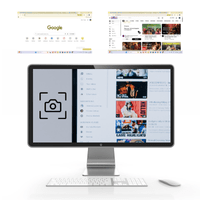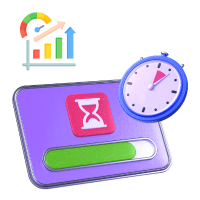
Flexible work arrangements are gradually becoming popular among today’s work world and workforce. We already know it’s because of human resources loving being in charge of their work locations and schedules, and for 2026 and beyond, they want more of it.
You see, flexible work settings have benefits for both employees and employers, and we will discuss that and more in today’s blog. However, first, let’s see how this unique way of working started.
How Flexible Work Arrangements Came into Existence
Did you know that around 80% of businesses provide employees with flex jobs, and it also attracts 7 times more applicants than traditional roles? While organizations choosing the different types of flexible work arrangements is not a new concept, what has given it more glory over the recent years is the advancements in technology.
What are Flexible Work Arrangements?
Flexible work arrangements are business policies that provide workers with a choice regarding how, when, and where they want to work. There are plenty of flex work setups available these days, such as hybrid, flextime, compressed, and job sharing.
Read Also: XNXP Personality Traits: Unlock Workplace Productivity & Collaboration
Top 9 Categories of Flexible Work Arrangements in 2026
According to our experience and expertise, there are plenty of setups that allow employees to work flexibly. However, we will talk about the 9 most common and successful ones here, only for some reason, with real-life flexible work schedule examples.
1. Remote Work
We all know what this one is. Don’t we? The remote work, which is also known as work-from-home or work-from-anywhere. This one is so famous that it’s a central component of most of the flex job arrangements out there.
Example: in 2021, LinkedIn updated its work policies, allowing a majority of its workforce to go fully remote, instead of the rule that employees needed to clock in the office 50% of the time.
2. Hybrid Settings
This one is a combination of remote and in-office work arrangements. Employees report to the office on some days of the workweek only. This can be done in various ways, such as:
- Employees split their time evenly, working on-site and remotely.
- Team members mutually agree, who reports to the office each day.
- Employees decide when, where, and how they work best.
Example: Amazon needs its employees to clock in to the office 3 days per week, while they can work from anywhere for the remaining 2 days.
3. The 4-Day Workweek
The 4-day workweek, also called the compressed workweek, is one where employees work 4 days weekly instead of the standard 5. It depends on you whether you will make this flexible work arrangement 10 hours per day or cut back on meetings, distractions, and other unnecessary things to wrap it all up in just 32 hours per week. Other arrangements here include:
- 40 hours per week = 4 days * 10 hours
- 38 hours per week = 5 days * 7.6 hours
- 32 hours per week = 4 days * 8 hours
- 30 hours per week = 5 days * 6 horus
Example: At Buffer, when they dropped the need for employees to work 40 hours per week, employee stress reduced, and freedom and happiness increased significantly.
4. Flextime
Employees can choose their start and end times for each workday. This is okay as long as they meet the required weekly work hours. However, managing this can be complex, even for employees. We recommend using the best employee scheduling software to simplify schedule creation, sharing, and management.
Example: The staff at Dell can make their own work schedules and use online collaboration tools to remain updated with team members.
5. Results-Only Work
This is one of the most favorite flexible schedule examples for employees. Why? That’s because the number of hours employees work weekly doesn’t matter. Human resources don’t need to clock in and start working at a fixed time. Plus, there is no need to inform your employer when you are traveling or taking a leave. However, as the name suggests, you need to provide the expected results only.
Example: The work culture at Zapier allows employees to choose how, when, and where they work best. Their only concern is the result, for which the teams are accountable.
6. Unlimited PTO
This one is the most favorite flex work setup for employees. That’s because it provides freedom to take that one thing, which teams love the most. That is PTO or paid time off. The only catch is that employees need to meet their performance goals and responsibilities.
Example: At Netflix, employees can take PTO or paid time off according to their needs for a better work-life balance.
7. Annualized Hours
If you transition to this approach, you need to pay your employees on the basis of the total number of hours worked per year. Simply put, you call your employees in when they are needed. Otherwise, they can do whatever they want.
Example: Businesses in manufacturing and logistics, where the workloads fluctuate a lot, use the annualized hours arrangement.
8. Job Sharing
This one lets you and your colleagues share each other’s work and time in part-time arrangements, making it a full-time setup. However, the only downside to this is that employees will not get traditional benefits.
Example: Microsoft has successfully implemented this flexible work arrangement over the years.
9. Voluntary Reduced Work-Time
This is one of the types of flexible work arrangements where employees have the option to reduce their working hours while maintaining the status of full-time employment. Overall, this lets employees balance their personal and professional lives more effectively.
Example: Dell is a good example of a business that allows this type of scheduling.
Benefits of Flexible Work Arrangements for Employers
Usually, when we hear the term flexible work arrangements, we think that the advantages are only for employees. However, employers also get their fair share of benefits. We are getting these:
- Reduced Overhead Costs: Transitioning to remote or flexible or remote work arrangements results in major savings for bosses. According to research, it can be up to $11000 per worker because of decreased office space, utilities, and other overhead expenses. To save even more time and costs, use the best time tracking software.
- A Wider Talent Pool: The overall result is a better quality workforce for you due to diverse skill sets and perspectives, because of a wider range of applicants from around the world being interested in working for you.
- Improved Employee Retention: Your employees will likely stay loyal to you due to improved work-life balance in the long run.
- Boosts Productivity: Did you know that remote or work-from-anywhere employees are 15% more productive on average? Employees who are free to choose their work times and atmosphere are more efficient and motivated in their tasks.
- Heightens Employee Satisfaction: Flexible work arrangements result in lower employee stress, happiness upshifts, and increased productivity.
Benefits of Flexible Work Arrangements for Employees
Implementing a flexible job setup has been fruitful for our employees as well. Plus, to track their productivity, we use the best productivity tracking software, so workers are also meeting expectations while maintaining work-life balance:
- Improved Work-Life Balance: When employees can freely choose their work locations and schedules, they maintain a healthier work-life balance. Overall, it lowers stress bars and increases life satisfaction.
- Better Independence: Employees working flexibly get the empowerment of freedom, increasing job satisfaction and engagement.
- Improved Financial Wellness: Flexible work arrangements frequently decrease or get rid of commuting needs. Plus, it also limits extensive childcare or caregiving services, which saves time and lightens financial burdens.
- Reduced Burnout: This is due to the ability of your workers to take required breaks, work at peak productive hours, mitigate long commutes, and select an atmosphere that boosts creativity.
- Enhanced Well-Being: Tailored work setups let workers select an atmosphere that meets their individual requirements. It can be working from a comfortable home office or adjusting the schedule to compensate for hobbies and passions. Overall, it improves employee well-being.
Steps to Successfully Implement a Flexible Work Arrangement
Want to implement one of the best types of flexible work arrangements as per your requirements? You can’t transition to it right away. Here’s what you need to arrange for (pun intended) first.
1. Policy Transparency
First, we need to make a clear work policy for flexible working. For the same purpose, you need to:
- Determine eligibility
- Outline the options available
- Set expectations
2. Secure Leadership Buy-In & Support
It is also essential to get the support of your leaders and their approval, for which you must:
- Understand concerns
- Align with business objectives
- Highlight risk avoidance
- Show data-driven proof
- Pilot program as proof of concept
- Create a collaborative platform
3. Invest in the Right Tools
As we mentioned before, most of the flexible work arrangements are centered around remote work setups. So, you will also need:
- Collaboration platforms
- Cloud storage
- Video conferencing
4. Gradually Expand
Select a team or department first to test how your flex job setup works out. It’s crucial to collect feedback before spreading it across your entire business so that you get the best results. Concerns from your leaders play an important role here.
5. Communicate
Good advice is to properly communicate what you expect from your employees. Plus, providing enough training to efficiently work in a flexible atmosphere is also crucial. What we do is maintain a proper, open, and two-way communication channel via regular check-ins and feedback loops to properly and quickly handle concerns and, of course, adjust.
6. Adapt & Measure
Before jumping to a flexible work setup, you also need to monitor KPIs, such as productivity, employee engagement, and retention. This will help you evaluate how effective the transition will be. Using employee feedback for continuous enhancements, and customizing and adjusting the configurations to suit your business and employee requirements is also wise.
7. Maintain Organization Culture
Maintaining a strong organizational culture is not only possible in in-office arrangements. You can also do this in flexible work arrangements via these tips and strategies:
- Annual retreat
- Virtual team-building events
- Reward programs
- Virtual lunch hours
- Take feedback and surveys
Read Also: All You Need to Know About Process Mapping for Your Projects
The Latest Flexible Work Trends for 2026
When choosing one of the flexible work schedule examples to transition to, you also need to watch out for and adapt to the latest trends. These are some interesting patterns, which we realized for 2026.
1. Part-Time Work
Reduced or part-time work hours allow workers to work fewer hours than a standard full-time schedule. This provides employees with enough time to seek medical appointments, caregiving opportunities, and maintain effective energy levels and well-being. Thus, this setup will specifically appeal to:
- Caregivers
- Individuals having particular medical conditions
- Employees who are chasing education or other professional development activities.
- Anyone who needs a better work-life balance in general.
2. Offer Sabbaticals
Rather than having them quit, retire, or simply settle for a one or 2 week vacation, provide your employees with sabbaticals to let them extend time off from work. This ensures that workers return refreshed and inspired, ready to provide their best at work. Depending on the staff member’s tenure and your business policy, this type of casual leave can be between several weeks to a few years. Also, while it’s not required, this one is a PTO, which ensures that employees get the benefits without the financial burden.
- Discovering personal interests
- Chasing personal development opportunities
- Spending more time with friends and family
- Volunteering
- World tours
Make Flexible Schedule Management Simple with DeskTrack
DeskTrack’s project management, scheduling, and employee monitoring software makes it simple for you to manage flexible work arrangements and also track whether employees are sincerely working or just taking advantage of the work model for their personal gain. Plus, if you want detailed real-time insights into the workflow and even prevent insider threats, it also provides real-time work insights with screenshot monitoring. Furthermore, it’s the complete workforce management package with flexible time tracking features as well. Try now and realize why 8000+ businesses around the world trust it.
Frequently Asked Questions (FAQ)
Q. What are Flexible Work Arrangements?
Ans. Flexible work arrangements are business policies that provide workers with a choice regarding how, when, and where they want to work. There are plenty of flex work setups available these days, such as hybrid, flextime, compressed, and job sharing.
Q. What are 3 Examples of Flexible Work Arrangements?
Ans. Here are a few of the common schedules for flexible working for employees.
- Remote Work
- Hybrid Settings
- The 4-Day Workweek
- Flextime
- Results-Only Work
- Unlimited PTO
- Annualized Hours
- Job Sharing
- Voluntary Reduced Work-Time
Q. Can I work 40 hours in 4 days?
Ans. Yes, you can. If you work for 10 hours every day from Monday, you will cover 40 hours in 4 days. That is:
- 40 hours per week = 4 days * 10 hours
Q. What are the Benefits of Flexible Work?
Ans. Flexible schedules for working have many benefits for both employers and employees:
For Employers:
- Reduced Overhead Costs
- A Wider Talent Pool
- Improved Employee Retention
- Boosts Productivity:
- Heightens Employee Satisfaction
For Employees:
- Improved Work-Life Balance
- Better Independence
- Improved Financial Wellness
- Reduced Burnout
- Enhanced Well-Being
Q. What are the Latest Trends in Flexible Working?
Ans. You need to adapt to these trends if you want to switch to a flexible work setup.
- Part-Time Work
- Offer Sabbaticals










